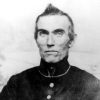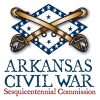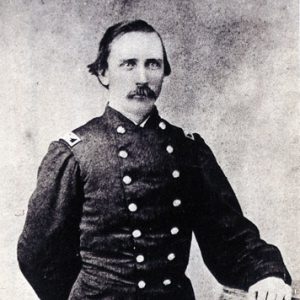calsfoundation@cals.org
Second Arkansas Cavalry (US)
Arkansas seceded from the Union in 1861, but support for the Confederacy was not universal among the population. In the mountains of north-central Arkansas, groups of men formed secret societies to resist Confederate authority (known collectively as the Arkansas Peace Society). Hundreds more fled to southern Missouri to escape persecution by secessionist forces. In other parts of the state, far from the Union lines, people were forced to bide their time and keep quiet. As a distinct minority in a state frenzied by war, many Arkansas Unionists could ill afford to have their true sympathies known.
During the summer of 1862, the Union army made its way to Helena (Phillips County) after an abortive attempt to capture Little Rock (Pulaski County). Situated at an important point on the Mississippi River, Helena would become the staging ground for many forays into the interior of the state. It also became a rendezvous point for loyal Arkansans seeking protection and vengeance.
In July 1862, Colonel W. James Morgan of Missouri opened a recruiting office on Main Street in Helena. He had been given permission by the War Department to organize a regiment to be known as the First Arkansas Mounted Rangers. Recruits came in daily as local Unionists seeking refuge flocked to the newly arrived army. Before long, there were three companies composed of nearly 400 men. However, mismanagement on the part of local authorities as well as the dismissal of Morgan from the service compelled officials to send the recruits to St. Louis, Missouri, in May 1863 in order to consolidate them with another Arkansas regiment. Not long before the order was issued, the unit’s designation was changed to the Second Arkansas Cavalry.
In August 1863, John E. Phelps, a resident of Springfield, Missouri (son of John S. Phelps, the former military governor of Arkansas), was appointed recruiting commissioner for the regiment. Phelps brought a great deal of experience to his new position and soon instituted an active campaign to bring the regiment up to full strength from his headquarters in Springfield. Not only were recruits gathered from the many Arkansas refugees in southern Missouri, but regular scouting parties were sent into northern Arkansas to secure additional men, including former members of the Peace Society. Many other men joined at Fort Smith (Sebastian County) and mustered into the regiment. Finally, on March 18, 1864, the Second Arkansas Cavalry Regiment, with twelve full companies, officially mustered into Federal service with Phelps as the colonel. By this time, the regiment was composed not only of loyal Arkansans from nearly every region of the state, but also a fair number of Missourians, a smattering of Texans, Choctaw, and Chickasaw, as well as soldiers from Tennessee, Kansas, and Illinois.
While the unit was still organizing, and throughout the course of the war, the Second Arkansas spent much of its time patrolling northern Arkansas in search of Confederate guerrillas and bandits who preyed on the local population. Their knowledge of the terrain and familiarity with the population made them a potent instrument in the federal government’s arsenal. Although the regiment rarely acted as a united command—as small detachments were often scattered around the countryside—the men proved themselves quite capable of inflicting serious damage on Confederate forces in the area. Such prowess did not come without loss though. On May 3, 1864, a foraging party from the Second Arkansas was ambushed by guerrillas at Richland Creek. The Confederates refused to take prisoners, and by the time the fighting was over, nearly forty men from the Second Arkansas lay dead.
The regiment was not only successful at conducting counter-guerrilla operations, but it also proved its worth at fighting regular Confederate forces. In the fall of 1864, the unit helped counter Sterling Price’s Missouri Raid, the only Arkansas Union regiment to do so from start to finish. Then, in January 1865, the unit was transferred east of the Mississippi River and served in Tennessee and Mississippi until the end of the war. The Second Arkansas was the only Arkansas Union regiment to serve extensively outside the state during the fighting.
In addition to serving in active campaigns, the regiment also performed important duties such as garrisoning military posts, escorting supply trains, and protecting pro-Union citizens. From humble beginnings, the regiment was able to meld itself into a cohesive and disciplined fighting force that had significant impact upon the war.
For additional information:
Allen, Desmond Walls. Second Arkansas Union Cavalry. Conway, AR: Arkansas Research, 1987.
Robertson, Brian K. “Men Who Would Die by the Stars and Stripes: A Socio-economic Examination of the 2nd Arkansas Cavalry (US).” Arkansas Historical Quarterly 69 (Summer 2010): 117–139.
———. “Men Who Would Die by the Stars and Stripes: The 2nd Arkansas Cavalry (US) during the American Civil War.” MA thesis, University of Arkansas at Little Rock, 2008.
Brian K. Robertson
Butler Center for Arkansas Studies










Comments
No comments on this entry yet.